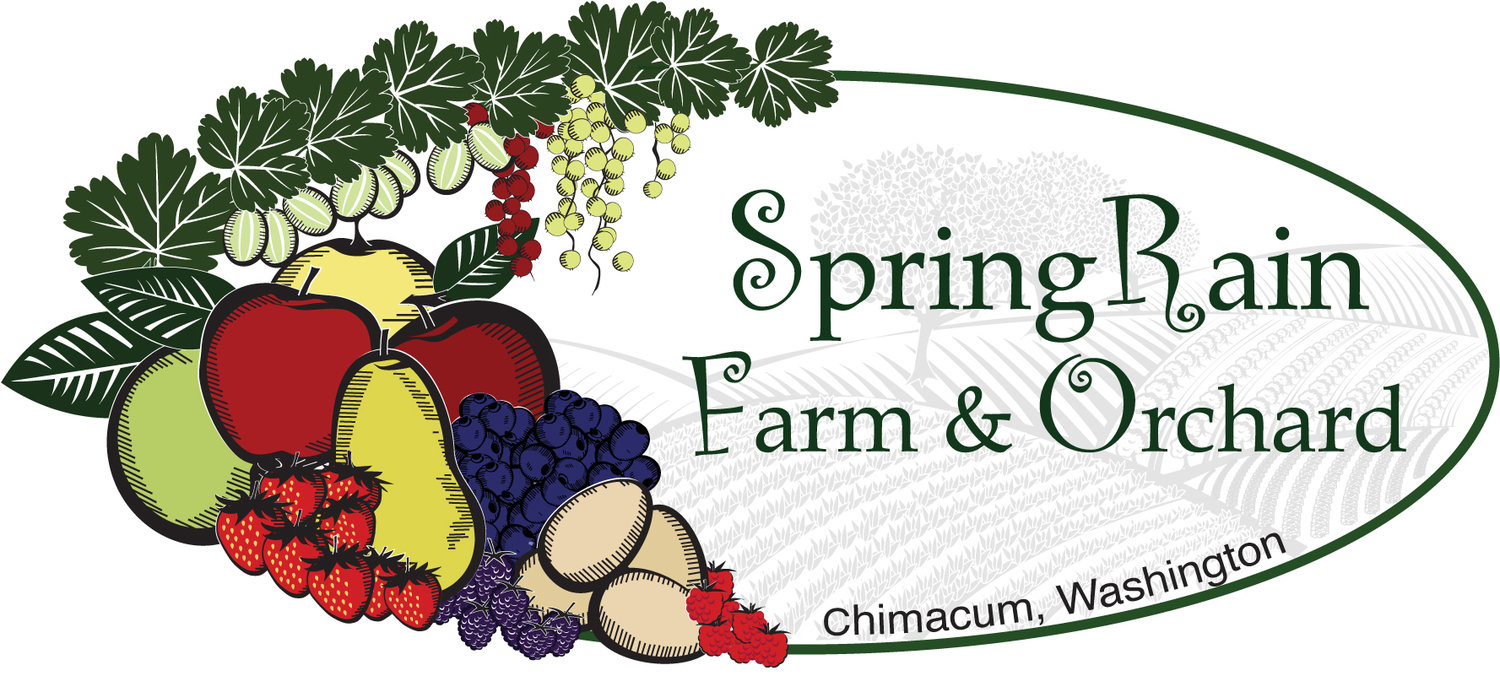When we began farming in Chimacum 10 years ago, we began a journey focused on organic, sustainable, low-carbon growing for our local community. John captures the essence of our vision in this motto that we still use and believe in today: Local production for local needs; Sustainable means to a sustainable end. We are asking for your support to help us produce more organic food for our community and help reduce the contribution of agriculture to human-made climate change.
We grow food in a system of integrated practices that attempt to mimic natural ecosystem functions. As part of our diversified approach, SpringRain Farm produces many different crops that harmonize well spatially and seasonally. Our orchards contain apples, pears, and plums and we raise many different kinds of berries. The understory of the orchards provide a comfortable place for our chickens, ducks, and turkeys to forage, rest, and play while reducing pests and disease. We focus on providing the right environment and growing conditions for each plant or animal so it can flourish. The integration of conservation hedgerows, riparian buffers, and native plantings provide habitat and refuge for abundant populations of waterfowl, song birds, reptiles, amphibians, beneficial insects, and native pollinators. We actively seek to reduce our carbon footprint and see ourselves as positively contributing to the fight against climate change.
So why do we need your help? We would like to expand our ability to grow food for our community this winter by increasing the amount of passive solar greenhouse space we can grow in. We have several unheated greenhouses we use to grow year-round so our local community can access locally-grown fresh food in the winter and not have to rely on produce trucked in from California and Mexico or flown in from Chile. This further reduces the carbon footprint of our community. By crowd-funding with many small contributions, we can move ahead quickly to meet the immediate demand for our products by adding an earth-sheltered passive solar greenhouse this winter.
Give today and help with:
· Earth moving
· Wall building for thermal mass
· Obtain and install a greenhouse frame and plastic covering
· Ventilation and irrigation
Help us move forward on our low-carbon farming journey as we work to fight climate change. All gifts will be used for materials and construction costs.
Stepping Stones on Our Journey Through Low-Carbon Farming
The conservation easement we donated to the Jefferson Land Trust protects 21 acres of prime agricultural land and 1000 feet of Chimacum Creek, a salmonid stream. This land can never be used for anything other than agriculture indefinitely and we have set aside 4 acres along Chimacum Creek as a riparian reserve.
We protect 8 acres of wetlands that we have planted to native trees. While our scientist farmer says he can’t calculate the amount of carbon we sequester each year because we don’t know how much gas is emitted by the organisms eating decaying plant matter or how much the plants have grown, on average freshwater wetlands sequester .5 ton of carbon per acre a year. With over 800 native trees planted, we sequester even more.
The 9.8 kw solar array we put on the top of our chick brooder house provides 16-20% of the farm energy needs.
Our most recent move toward negative carbon farming is the purchase of two used electric trucks we can use to move feed and harvested produce around the farm.
We are growing our second season in an earth-sheltered passive solar greenhouse that uses the natural heat of the earth to create favorable growing conditions. The greenhouse is sunk 5 feet in the ground to take advantage of the natural warm soil temperatures and has raised beds made of concrete to capture the heat of the sun during the day and radiate it at night to keep the plants warm.
Our work with the Olympic Salmon Coalition has allowed us to remove a berm and insertion of woody debris to restore the creek salmon spawning beds.
We planted over 1400 trees in the riparian buffer around Chimacum Creek, which have put on tremendous growth over the years and sequestered more and more carbon each year in their wood and in the soil underneath them. Over the last 10 years, the trees have grown into a legitimate forested area and are shading and cooling the creek water for salmon and trout.
Our 5 acres of blueberries have a perennial grass-clover planting between the rows, which sequesters an estimated .5 tons of carbon per acre per year along with the carbon sequestered by the blueberry plants. Our male rabbits graze on the perennial cover and keep it growing strong.
The 5 acres of orchards we planted in 2009 also have a grass perennial cover which sequesters carbon along with the trees themselves.
We mulch all of our fruit trees, berries, and perennial crops and with waste hemlock-alder sawdust from a pulp plant that would otherwise burn it as a waste fuel (keeping the carbon on our ground and in our plants).
We use the same sawdust in our chicken, duck, and turkey coops which we then compost to form soil to put back out on the land to feed our plants.
Throughout the farm, we have planted vegetative buffers to provide habitat for beneficial insects and pollinators and placed over 50 swallow nest boxes as part of our integrated pest management plan. Visitors remark about how many snakes, toads, frogs, bees, birds, and fish they see on our farm.



